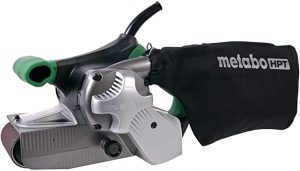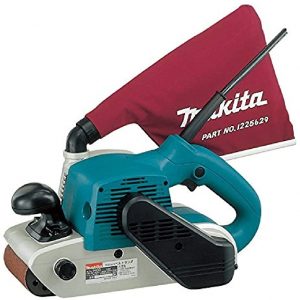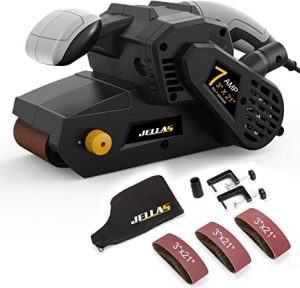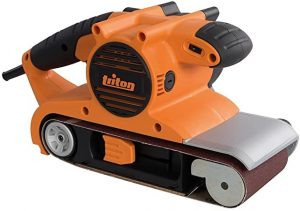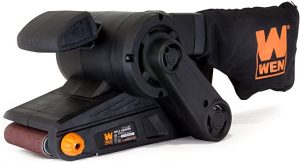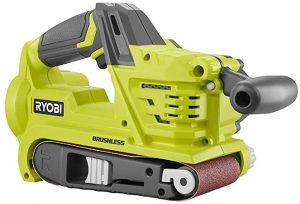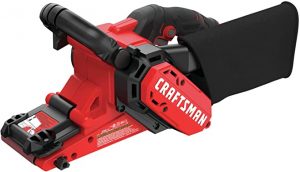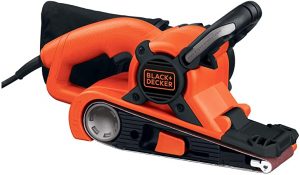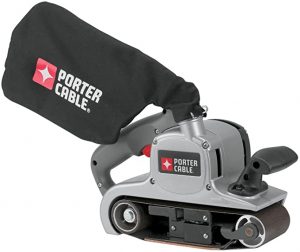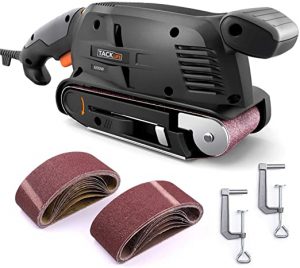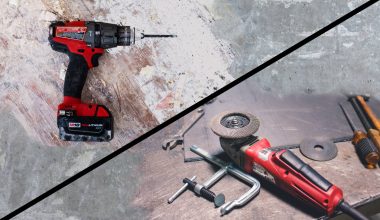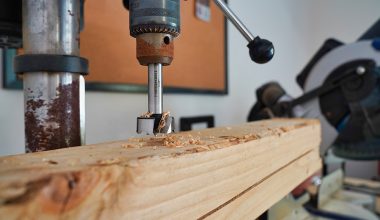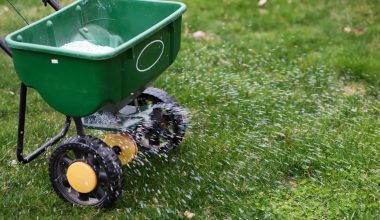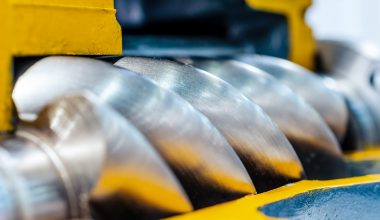No DIY/home renovation project is complete without a smooth finish, and sanding is the perfect way to achieve this. For small projects sandpaper is great, but for most DIY projects/tasks you’re going to need an electric sander. This is a must-have for beginning your journey in DIY. Portable belt sanders are common in the workshop and are used for shaping a project or sanding down plenty of material in a short space of time.
Belt sanders are the only electric sander that will efficiently remove large amounts of material. An electric motor spins two drums in which a belt of sandpaper is attached. This creates a high speed, continuous sanding mechanism. They are mostly portable but stationary versions also exist, but these are more expensive.
Electric belt sanders range in price depending on a few key features but are still affordable. The best belt sander products and their reviews are listed below and should help you decide which one is right for you.
Important Belt Sander Features
Dust collection
Since electric belt sanders remove excess material quickly, this also results in a lot of dust. Not only gets it all over your workspace, but it gets into your eyes, mouth and so on. This can be dangerous when inhaled in large quantities, as well as extremely annoying. A dust collection bag or vacuum feature is a key feature for your belt sander.
Grip and handle comfort
Since you’ll be holding your belt sander constantly when sanding, it’s important that the handle material is comfortable, or the grip is not too harsh. The use of a high-speed motor means an unsuitable grip can cause a lot of discomfort to a user’s hands. Consider sanders with rubber or elastic grips, or any made from material which is comfortable on the hands.
Variable speed setting
Due to the belt sander being useful for a variety of jobs, a variable speed setting is important to have to ensure the right speed for the right job. Higher speeds are great for shaping and sanding large surfaces, yet they don’t smooth surfaces too well. Lower speeds are better for a smoother finish but will not remove as much, so it’s important to have both options.
Motor power
The speed at which the belt sander operates is key, so a motor with high enough power is essential to its function. Many electric belt sanders are around 120V which is high enough for efficient use, and many belt sander motors range from 5-10amps, with a higher amperage allowing longer use and less chance of overheating. Belt sanders with more power tend to cost more, so it’s important to compromise with other features.
Top 10 Best Belt Sanders
Best Overall
1. Metabo HPT Belt Sander
Key Features
Variable speed dial allowing interchangeable speed control between 820-1475 ft/min.
Soft elastomer grip on the main and auxiliary handles for a comfortable, secure hold.
Detachable dust bag which can swivel 360° allowing for clean and easy use.
9 Amp belt sander for tough sanding jobs.
Our Rating
Check Price
Our Take
The Metabo HPT Belt sander is our top choice in this list, as the combination of power and usability for a great price stands out by far. The 9 Amp motor provides a powerful sanding experience which is great for sanding rough material quickly, as well as making it unlikely that extended use will cause overheating. Even with its high power, the variable speed dial allows you to manage the sanding speed most suited to your job, making sure you don’t sand too hard.
For around $125 you can get a long-lasting, efficient belt sander with features that simply make it better than the others on this list. This includes a wear-resistant V-belt that provides extended life to the product, a flush surface design to allow for quick sanding, and a tracking window to improve the visibility of any sanding surface. These features, combined with the addition of a dust bag and a soft elastomer-grip surface on the handles, means this sander ticks all the boxes and is the best option.
It is more expensive than some sanders in this list and only comes with one sanding belt, but for its price and included features it really is a great investment.
Best Performance
2. Makita 9403 4″ X 24″ Belt Sander
Key Features
11 Amp motor with 240V voltage for maximum sanding power.
4-inch-wide belt with a speed of 1,640 feet per minute covering 24 inches in length.
Large front grip is positioned for operator comfort.
Only 84dB and is one of the quietest sanders in its class.
Our Rating
Check Price
Our Take
Makita never fails to provide a long-lasting, powerful tool no matter what the job and are commonly known worldwide. This Belt sander is the most powerful in the list at 11 Amps with 240 Voltage, allowing it to take its place as the best performing sander there is in this list. The speed and sanding efficiency of a 4 by 24-inch belt means large areas can be covered quickly but quietly.
A large front grip for comfort and a swiveling 360° dust bag ticks the boxes for any good sander, but additional features include a unique flush design and are double insulated for protection. This corded sander also has an easy lever for simple belt switching, making maintenance a breeze.
That said, there are two reasons it doesn’t take the top spot. Firstly, the price, as Makita tools are an expensive brand and you’ll pay at least $200-250 for this sander. For this price, it doesn’t have variable speed control, which can be a disadvantage for many beginner users and is an important feature.
Nevertheless, this tool is our best performing and if you’re not afraid to splash out or you’re not bothered about variable speed, this is for you.
Best Value
3. Jellas 7Amp Belt Sander
Key Features
2-in-1 dust collection bag with vacuum attachment for efficient dust extraction.
Variable-speed knob with 6 dials to alter speed from 120-400rpm.
7 Amp, 120V motor that can rotate the belt at over 13 ft / s
Addition of 10 aluminum oxide belts (40-180 grit)
Our Rating
Check Price
Our Take
Jellas isn’t the most known brand, but that doesn’t mean their tools aren’t any good. In fact, the Jellas 3 by 21-inch belt sander is the best value sander on our list, providing efficient and suitable use for a price of $59.99 on amazon.
Features such as a variable speed and dust collection port are included, but even with the low price, they are taken further than other sanders. The variable speed is in dial form which allows easy switching and the dust collection has a large volume and vacuum attachment. Furthermore, a unique over-mold handle really provides you with that extra grip and comfort, and alongside the 7Amp motor means this sander ticks all the boxes.
Providing the same voltage as some of the other sanders in this list, which makes this electric belt sander the most cost-effective is the including of 10 additional sanding belts. With 2 pieces each of varying grits (40, 60, 80, 120, 180), this saves you plenty of money on spare belts. Not only this, but 2 included clamp pieces to allow stationary use of this electric sander really widens the potential uses.
If you need to save money-this sander is for you.
4. Triton T41200BS Belt Sander
Key Features
Rear-facing dust port connected to the supplied dust bag
Variable-speed control
10 Amp, 1200W motor for rapid removal
Lock on button and over mold grip for additional ease of use
Our Rating
Check Price
Our Take
This 10-amp Triton belt sander just comes short of our best product on the list, and only because compared to our number one spot, it’s simply more expensive. It’s rated at four and a half stars and has had some excellent reviews, stating that this heavy-duty 4″ x 24″ sander is excellent and really taking off material quickly.
Its best feature would be the comfort and ease of use, which is ensured by a lock-on button for long periods of sanding and a specially designed over-mold grip that keeps your hand comfortable. As well as this, the dust collection mechanism allows you to keep a clean workspace when sanding, which is needed here as the 10-amp motor really gives you that bit more power.
However, there is also the belt tracking adjustment feature which allows the user to securely control the belts, but some reviews have stated that this feature sometimes doesn’t work properly-so if you’re going to get this sander, watch out for this. Apart from that and the price of this sander, it really is a great choice and if you need a sander with 4″ x 24″ belt space, this belt sander is for you.
5. WEN 6321 Corded Belt Sander
Key Features
Supplied dust bag
Weighs in at 6 pounds to prevent fatigue from heavy use
7-Amp motor rotating the belt at over 13 feet/s
Lock on and easy belt switch button
Our Rating
Check Price
Our Take
Compact and lightweight, this electric belt sander by WEN is the cheapest on the list but with some great reviews, hence its positioning in this list. For just under $40, you can get an efficient, easy to use belt sander which has the features you are going to need.
The ergonomic handle allows you to securely use the sander with some comfort, especially with the lock on button. The bright orange switches, including the belt switch, add a pleasant aesthetic look to this sander but also give it that versatility. The tracking adjustment knob is a useful feature to ensure the belt runs straight, and the dust bag is the final feature that really ticks the boxes for this great value sander.
This said the only issue would be no variable control, as well as its cheap nature resulting in reviews stating the reliability of this sander is not the best. However, it also means if you are starting out and need the cheapest sander possible, you can get most of the features you need for a great price. To make up for the lack of variable speed, the front extends to allow you to reach those hard to get places.
6. Ryobi P450 Brushless Belt Sander
Key Features
Adjustable pommel up to 5 different positions for top-tier ergonomics
Rubber molding handle
Cordless tool for easy, versatile use
Dust bag and sanding belt included for efficient sanding.
Our Rating
Check Price
Our Take
Ryobi is well known for their long-lasting, powerful electric tools which are some of the most reliable on the market. With this comes the price, which is on the expensive side for an electric belt sander, but it really will last you longer than most sanders.
Like most sanders, a dust bag is included, and the ergonomics of this tool is probably the best on the list. However, no variable speed does limit it slightly, but this can be seen to be made up for by the speed and power of the tool. An 18V battery really has an effect, and even better, can be used in other Ryobi cordless tools to make life a bit easier.
The brushless motor feature means this electric belt sander has a greater runtime and lifetime than most others. It is a great tool to have but for the price, and the fact that some reviews have issued reports such as sliding belts, you can get a more impressive sander for less.
However, if you need a belt sander that will last you a long time and you’re not afraid to splash out then this is for you, especially if you have Ryobi tools.
7. CRAFTSMAN Belt Sander
Key Features
7-Amp belt sander with angled design
Easy belt release button
High performance dust collection.
Over molded handle improves comfort during use
Our Rating
Check Price
Our Take
The craftsman belt sander is an ideal, compact tool to have in the workshop and for a price of around $60, it can get the job done. At 7-Amps it has some reasonable power, with the dust bag preventing any mess that will get in the way. The tool-free belt release means that once used up, you can swap out the belt and replace it at the touch of a button, allowing easy use.
However, reviews have mentioned issues with this feature, saying it can really be tough to switch belts properly, and even then, belts can come off during use. As well as this, some notes on the dust collection bag not being secure have also been noted. No accessories are included either.
Despite this, its angled belt design allows you to get into some difficult places and onto adjoining surfaces. It might not have a couple of key features and some problematic reviews, but if you need a comfortable belt sander with some reasonable power, it might just be suitable for your project.
It’s also worth noting that as a brand, Craftsman is great for beginners. So, if you need a starter sander, this is for you.
8. BLACK DECKER Belt Sander with Dust Bag
Key Features
Front roller design allows you to reach even the tightest corners
Retractable, three-position handle for optimum ergonomics
Flush design for sanding against vertical surfaces.
7-Amp motor
Our Rating
Check Price
Our Take
This high rated, great value amazon favorite is a great choice for DIYers that need a belt sander that will get into those tight and awkward corners. The extended front roller design allows this, as well as having a 7-Amp motor to power it. The dust collection bag and 3-position handle is perfect for comfortable and clean use in sanding.
No variable speed, however, can mean difficulty in precision sanding, especially on the awkward corners. This can result in a difficult sanding experience when trying to really get the perfect level on corners or angles, so for this purpose variable speed is needed. It’s also noted that it can be slippery and annoying by some buyers, but the majority have had a pleasant experience.
It’s further down on the list because regarding belt sanders available, you’re better off spending that bit more for a sander with more features. As well as this, for the same price, you can get a sander with better reliability and lifespan. However, just like a few in this list, it’s a great tool for a beginner home improvement enthusiast or if you won’t be sanding so often you’ll wear it out.
9. PORTER-CABLE Belt Sander with Dust Bag
Key Features
Variable speed dial
Quick release belt and belt tracking knob
8-amp motor
360° swivel feature on the dust bag
Our Rating
Check Price
Our Take
Coming with a variety of features, the Porter-cable belt sander is a rigid, strong sander that is suitable for heavy use. For its power at 8-Amps, it’s great for sanding floors or heavy stock removal. The advanced dust bag and variable speed dial also tick the boxes for an efficient belt sander, allowing easy and straightforward use as well as a clean job.
However, the reason it’s towards the bottom end of the list is that for around $170, you are not getting the best value for money. Firstly, the ergonomics of this product are not best for its use, meaning for excess sanding and heavy use you need that extra comfort.
Secondly, it might tick the boxes for the features needed in an electric belt sander, but the reviews of this product have reported various issues with this product. This ranges from overheating motors to poor dust collection, and for the price you’re paying, that should not be a worry.
That said, these could be a few specific products and as a brand, Porter-cable has high quality products. This does mean paying excessive amounts, and for this electric belt sander, it might not be worth it for your jobs.
10. TACKLIFE 3 ×18-Inch Belt Sander
Key Features
5-Amp motor
Comes with accessories and 2 screw clamps.
Lock on feature and variable speed dial.
Dust box and two vacuum adapters
Our Rating
Check Price
Our Take
You might be surprised to see this so down the list, as the Tacklife belt sander is a great option regarding product features. The dust collection mechanism comes with a box and two adapters, meaning clean use is guaranteed. As well as this, a variable speed knob and lock on button means you can easily sand your surfaces effectively.
As well as this, the product for around $50 comes with 13 extra 80 and 120 grit sanding belts, saving you money in the long-term. To expand its use as a sander, two metal clamps are included too for stationary use. With these accessories-this electric sander is value for money.
However, the reason it is so low down is because of its power. At 5-Amps, this sander is only ideal for smaller jobs or surfaces which do not need constant or heavy sanding, as reports of overheating or shutdown have been reported. For the same price or slightly more, you can get a 7-Amp motor which is far more reliable.
Nevertheless, if you’re not sanding heavy surfaces for too long, this electric belt sander could be for you. Be warned, there have been some problematic reviews, so these are worth a look.
Ultimiate Belt Sander Buyers Guide
Before you pick up any sander, whether it’s a belt sander or orbital sander, it’s important to know how to use one.
Our top tips for effective sanding:
- Do not press too hard-this will just take off more material than you want.
- Before starting the sander, ensure the dust bag or attachment is secure and that the belt is tightened in.
- Hold with two hands and gently apply to the material, gradually putting more pressure on as you sand.
Like any sander, an electric belt sander simply involves applying pressure gradually to your material to take it off, following a back and forth motion. If you make sure everything is in check beforehand, you’re good to go.
To make sure you get your money’s worth, there are a few more things to look for when buying. If you’re still uncertain about which belt sander is best for your workshop, the features below will help you decide.
Accessories included With Belt Sander
Belt sanders alone are a worthwhile investment and will provide you with plenty of use in the workshop. However, due to the nature of their use, sandpaper will be used up relatively quickly on larger jobs and so replacements are needed. Consider the type and quantity you need. Any belt sanders available that include accessories or spare sandpaper is always value for money.
Due to the variability electric belt sanders offer, different sandpaper belts can be used for different materials and therefore different tasks. The most common sandpaper used is aluminum oxide belts. They are the most affordable and durable, but for materials other than the wood it’s worth checking what type you need. It’s also worth checking what grit size paper you need. Lower grit is for more rough sanding and shaping, whereas higher grit is for smoothing and polishing.
Therefore, before purchasing any electric belt sander you should check whether it comes with accessories or not. This is not a huge issue as most users will be focusing on projects involving wood, and so only need aluminium oxide belt replacements, which are not costly. However, it can still save time and money if there are these accessories included.
Easy belt-switch mechanism
Electric belt sanders are likely to be used in most DIY projects both around the home and in the workshop. This will eventually result in the need for belt change when they wear down. Even if you don’t use your belt sander much, you’re going to have to change it at some point. Therefore, it needs to be simple and straightforward.
For most electric belt sanders, all you need to do is loosen or dethatch the sandpaper and replace it, tightening it back in place. Some cheaper brands have been noted to make this process difficult. But most electric sanders on the market come with an easy replacement mechanism that should prevent this. This might be a release clip or belt tracking adjustment feature.
As most sanders come with a sort of feature that should help with this, it’s still important to look for any mention of easy belt replacement in the product details. If you want to go one step further, check the reviews on any sander you look at about replacing the belt. Whilst this shouldn’t hold you back in your sanding progress, it can make life difficult.
Lock on feature
Since Belt sanders allow for shaping of a project or smoothing down large surfaces or large projects, it’s likely you’ll have it switched on with the power button held down for long periods of time. This can be a pain on the hands and decrease durability in using the sander. Not to mention the discomfort if the handle isn’t the most ergonomically suitable.
However, a good amount of electric belt sanders on the market have something called a lock-on feature. This allows the user to simply press it down and the sander will continue functioning without the need for the user to hold the switch. This makes life a lot more comfortable when sanding, but also allows both hands to be used easily when sanding.
Since you can simply stop sanding at any time and release your finger, this is not too much of an issue. However, it really makes a difference to your sanding technique and the time it takes to complete sanding a piece. Therefore, it’s a feature worth considering and will make your sander easier to use.
Belt size
The size and dimensions of your belt sander will make a difference to the amount of material you are able to sand. Larger sanders allow for more room for sandpaper, so more can be sanded in each time. This information will be available in the product specifications.
A 3-inch-wide sander is the typical length for most, if not all but high end, portable electric belt sanders on the market. However, the length of the belt will be either 18, 21 or 14 inches long. This can make a huge difference as to the amount of material you can cope with at a time. For most projects, 21 inches is a great compromise between 18 and 24, as 18 can be too small for larger pieces and 24 can be unnecessary.
Most belt sanders on the market are 3 by 21 inches, but make sure to check the specs for this. Furthermore, if you’re going to be doing a big job such as decking or floorboarding, products with 4-inch width would be more suitable. These are more costly, but its worth splashing the dollars for these sorts of products, as it will make life a lot easier for you.
Clamps included
Despite most electric belt sanders used in the workshop being portable and versatile, it’s one tool that is great to use in a stationary mode. As well as this, it’s one of the few portable tools with accessories, can be made stationary. By using belt sander clamps to hold the product down on a workspace, it can be used as if it were stationary by the user. This can be a really useful feature in the workshop and especially if your sander is on the heavier side.
This is perfect when you need some accurate sanding or shaping, as both hands are available and you don’t have to worry about it slipping. Clamping is a secure method of holding objects in place. Furthermore, it can help the sandpaper to last longer, as you have more control over the force applied.
Check if your belt sander comes with additional clamps as these are not expensive separately. But some belt sanders are designed to either not use clamps or only use the clamps included. This is optional of course, but it is a great option to have and opens more doors than portable sanders without this feature.
FAQ’s
How long does a belt sander belt last?
This largely depends on the type of belt and what you’re using it for. But aluminium oxide belts generally last the least time due to their inexpensive nature. They will wear out quicker on rough surfaces too. A belt cleaner is ideal if you want to preserve your belt.
What is the best sanding belt for wood?
The most common and most appropriate is the aluminum oxide belt. This is the cheapest and most available blet type. It will easily get your wooden material sanded down efficiently and smoothly at lower speeds. However, for harder woods and tough wooden material, using a Zirconia belt. This will last around 5 times longer than aluminum oxide belts but are more expensive.
What is a belt sander used for?
In its simplest terms, a belt sander uses a large area of sandpaper and a motor to remove excess material from an object for both smoothing and shaping. This is commonly used in DIY and renovation projects for a variety of materials such as wood, metal, glass etc.
Why do the belts keep breaking on my belt sander?
This can be due to a range of reasons. The most common reason this happens is the way you might store a sanding belt. They are sensitive to temperature and humidity. Furthermore, the tension on the belt after use can wear the belt out. If not, then the belt may not be secured properly or is being used with too much pressure.
Store your belts in a humidity-controlled area and in room temperature. As well as this, sealing them might be ideal too. This will preserve them for longer and prevent them from waring out.
What does grit size on a belt sander mean?
Grit size is simply the size of the small grits in the paper, but this makes a difference as to how you will sand the material. Lower grits such as 40 or 60 are used for rougher material and can take plenty of material off. For example when shaping or removing excess material. On the other hand, grits such as 120 and 180 are used for finishing touches and smooth sanding.
When sanding, gradually move upwards in number, as this will provide you with the smoothest possible surface.
